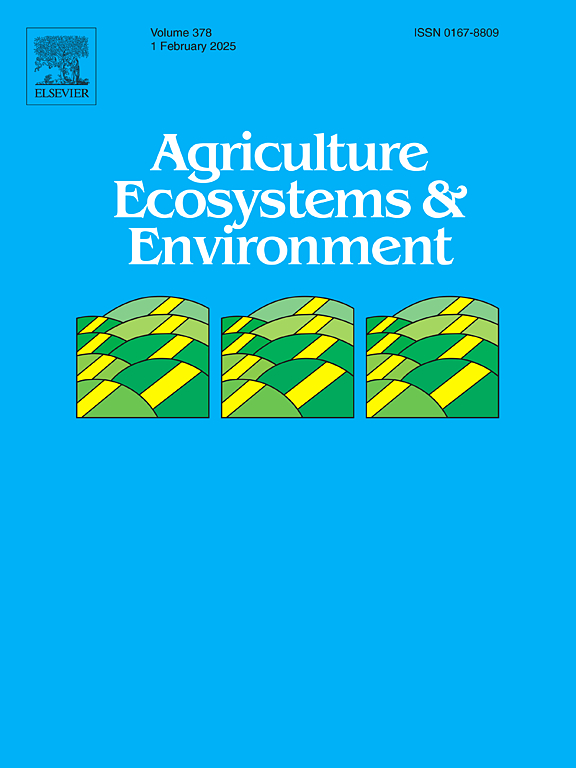绿色基础设施在集约化农业景观中为野生蜜蜂提供了重要的避难所:以西班牙公路为例
IF 6.4
1区 农林科学
Q1 AGRICULTURE, MULTIDISCIPLINARY
引用次数: 0
摘要
农业集约化和减少接近自然栖息地及其相关资源对野生蜜蜂多样性产生负面影响。西班牙的公路网络,一系列传统的路线,通过放牧和牲畜运动的实践得以保持,在减轻这些负面影响方面发挥了重要作用。该网络作为绿色基础设施的一种形式,提供永久性的半自然草原,作为传粉媒介在集约化管理的农业景观中的避难所。为了探索conconense公路对野生蜜蜂群落的影响,这条公路长400 公里,是西班牙中部Castilla-La Mancha最常用的公路之一,我们对240 公里的路段进行了采样,该路段横跨三个不同的生态区域(Campo de Calatrava, Llanura Manchega和Mancha Alta),这些生态区域在地质和地貌方面存在生物地理差异,可能导致蜜蜂群落的差异。我们在每个生态区内的三种土地利用类型(公路草地、半自然植被斑块和集约化农田)中使用平底陷阱收集野生蜜蜂标本。野生蜜蜂群落组成在3个生态区之间存在显著差异。当半自然生境可用性较低时,车道对物种丰富度和香农多样性有显著的正向影响。公路草地野生蜜蜂的功能丰富度显著高于半自然植被和农作物。半自然生境覆盖与人工道路的交互作用表明,人工道路对生境功能丰富度和分散度都有显著的正向影响,特别是在半自然生境覆盖较低的条件下。我们的研究强调,公路草地可以提供适宜的栖息地资源,支持蜜蜂的分类和功能多样性,特别是在集约化农业和半自然区域可用性减少的景观中。欧盟传粉媒介倡议强调需要恢复农业景观中的自然栖息地,并为传粉媒介创建生态走廊网络。在这种情况下,保护西班牙的公路网络是高度相关的。通过传统的迁移放牧来维护的公路草地,可以为野生蜜蜂和其他传粉媒介提供觅食和筑巢资源,特别是在高度集约化的农业基质中。本文章由计算机程序翻译,如有差异,请以英文原文为准。
Green infrastructure provides important wild bee refuges in intensive agricultural landscapes: The case of Spanish drove roads
Agricultural intensification and reduced proximity to natural habitats and their associated resources negatively impact wild bee diversity. The Spanish network of drove roads, a series of traditional routes which have been maintained through the practice of transhumant grazing and livestock movements, plays a fundamental role in mitigating some of these negative impacts. This network, functioning as a form of green infrastructure, provides permanent semi-natural grasslands that serve as refuges for pollinators in particularly intensively managed agricultural landscapes. To explore the effect of the Conquense drove road –over 400 km long and one of the most frequently used transhumant drove roads in Castilla-La Mancha (central Spain)– on the wild bee community, we sampled a 240 km section that extends across three distinct ecoregions (Campo de Calatrava, Llanura Manchega and Mancha Alta), which differ biogeographically in terms of geology and geomorphology, likely resulting in differences in bee communities. We collected wild bee specimens using pan traps across three land use types present within each ecoregion: drove road grasslands, patches of semi-natural vegetation and intensive crop fields. Wild bee community composition showed significant differences between the three ecoregions. Drove roads showed a significant positive effect on species richness and Shannon’s diversity when the availability of semi-natural habitat was low. Functional richness of wild bees was significantly higher in drove road grasslands compared to the other two land use types (semi-natural vegetation and crops). Moreover, the interaction between semi-natural cover and drove roads revealed a significant positive effect of drove roads on both functional richness and dispersion, particularly under conditions of low semi-natural habitat cover. Our study highlights that drove road grasslands can offer suitable habitat resources that support bee taxonomic and functional diversity, particularly in landscapes heavily transformed by intensive agriculture and with reduced availability of semi-natural areas. The EU Pollinators Initiative emphasizes the need of restoring natural habitats in agricultural landscapes and creating a network of ecological corridors for pollinators. In this context, the preservation of the Spanish network of drove roads is highly relevant. Drove road grasslands, when maintained through traditional transhumant grazing, can provide feeding and nesting resources to wild bees and other pollinators, especially within a highly intensified agricultural matrix.
求助全文
通过发布文献求助,成功后即可免费获取论文全文。
去求助
来源期刊

Agriculture, Ecosystems & Environment
环境科学-环境科学
CiteScore
11.70
自引率
9.10%
发文量
392
审稿时长
26 days
期刊介绍:
Agriculture, Ecosystems and Environment publishes scientific articles dealing with the interface between agroecosystems and the natural environment, specifically how agriculture influences the environment and how changes in that environment impact agroecosystems. Preference is given to papers from experimental and observational research at the field, system or landscape level, from studies that enhance our understanding of processes using data-based biophysical modelling, and papers that bridge scientific disciplines and integrate knowledge. All papers should be placed in an international or wide comparative context.
 求助内容:
求助内容: 应助结果提醒方式:
应助结果提醒方式:


